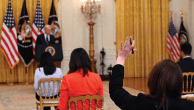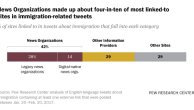Summary of Findings

While the media provided heavy coverage of the congressional elections last week, the public continued to track news about the nation’s struggling economy more closely than news about the midterm vote.
About four-in-ten (41%) say they followed news about the economy very closely last week, while 30% say they followed news about the elections very closely, according to the latest News Interest Index survey of 1,006 adults by the Pew Research Center for the People & the Press. By another measure, 24% say they followed news about the economy more closely than any other major story; 20% say they followed news about the elections most closely.
Election news dominated coverage, accounting for 38% of the newshole, according to a separate analysis by the Pew Research Center’s Project for Excellence in Journalism (PEJ). The economy was a distant second, accounting for 12% of coverage.
Throughout 2010, larger percentages of the public have said they are following news about the economy very closely than have said the same about election news. Though the public’s interest in election news has increased in recent weeks, the pattern set earlier in the year still holds.
In terms of media focus, coverage has tilted heavily toward the elections since Sept. 1. Midterm news has accounted for 25% of the newshole in this period, compared with 13% for the economy. Still, for the entire year so far, coverage of the two top stories is similar – 12% for the economy and 9% for the elections, according to PEJ.
With signs of potential large GOP gains in the election, Republicans continue to track election news more closely than Democrats or independents. Nearly four-in-ten Republicans (39%) say they followed election news very closely last week, compared with 27% of Democrats and 26% of independents.

Republicans also are more likely to say they are interested in elections around the country, rather than just those in which they can vote. Overall, the public is divided on this question: 42% say they are interested in elections around the country, while 43% say they are mostly interested in elections in which they can participate. Those numbers are little changed from the last time this question was asked in mid-September.
Six-in-ten Republicans (60%) say they are interested in elections around the country, while 34% say they are mostly just interested in those elections they can vote in. Among Democrats, more than half (53%) say they are mostly interested in the elections in which they can take part; 36% say they are interested in elections around the country. Independents are divided: 37% say they are interested in elections around the country, 40% say they are mostly interested in the elections they can vote in and 23% do not offer an opinion.
Nearly Half Say GOP Likely to Win House Majority
When asked whether they think it is more likely that Democrats will maintain their majority in the House or that Republicans will regain control, 48% say they think it is more likely that Republicans will win a majority of House seats. That is about the same as the 50% that said this at the beginning of October.

Among those following election news very closely, more than six-in-ten (62%) say the Republicans are poised to retake control. That drops to 43% among those following this news less closely.
Republicans remain confident. Nearly eight-in-ten (78%) say it is likely that their party will regain the majority it lost in 2006. A majority of Democrats (56%), however, says they think it is more likely their party will maintain control of the House. That is essentially unchanged from the 55% of Democrats saying this earlier in October.
Among independents, 48% say they think it is likely that Republicans will win control while 24% say it is likely that Democrats will hold on; 28% of independents do not offer an opinion. These numbers also are little changed from two weeks ago.
Mixed Ratings for Campaign Coverage

The public gives mixed ratings to the media for the job they have done covering the midterm elections, both nationwide and locally. More than four-in-ten (43%) say news organizations have done an excellent (8%) or good (35%) job covering elections around the country; 46% judge the performance as only fair (30%) or poor (16%).
Looking at coverage of state and local elections, 47% say news organizations have done an excellent (11%) or good (36%) job covering these contests; 43% say coverage of these races has been only fair (29%) or poor (14%). Differences among partisans on both the national and local levels are small.
The Week’s News

The public continues to track the ups and downs of the U.S. economy closely. About four-in-ten (41%) say they followed news about the economy very closely last week, while 24% say this was the news they followed most closely. Economic news accounted for 12% of the coverage measured by PEJ.
Three-in-ten (30%) say they followed news about the Congressional elections very closely, about the same as the 33% that said this one week earlier. Two-in-ten (20%) say this was the news they followed most closely. News about the elections accounted for 38% of the newshole.
About two-in-ten (21%) say they followed developments in Afghanistan very closely last week, while 10% say this was the story they followed most closely. The media devoted 3% of coverage to Afghanistan.
Just 17% say they followed news about potential breast cancer risks for women taking hormone treatments very closely and 8% say this was the story they followed most closely. This story received less than 1% of coverage. Not surprisingly, women were twice as likely to track this story very closely as men were (22% vs. 11%) and nearly three-in-ten women 50 or older (28%) say they followed this news very closely.
Two-in-ten (20%) say they followed developments about the “Don’t Ask, Don’t Tell” policy concerning gays in the military very closely; 6% say they followed this news more closely than any other major story. News about the policy accounted for 2% of coverage.
One-in-ten (10%) say they followed news about Supreme Court Justice Clarence Thomas’s wife calling Anita Hill to seek an apology for her harassment claims during the justice’s 1991 confirmation hearings. Democrats (14%) are slightly more likely to say they followed this story very closely than Republicans (8%) or independents (8%). Just 2% say this was the story they followed most closely; news about the call from Ginni Thomas to Anita Hill accounted for 2% of coverage.

These findings are based on the most recent installment of the weekly News Interest Index, an ongoing project of the Pew Research Center for the People & the Press. The index, building on the Center’s longstanding research into public attentiveness to major news stories, examines news interest as it relates to the news media’s coverage. The weekly survey is conducted in conjunction with The Project for Excellence in Journalism’s News Coverage Index, which monitors the news reported by major newspaper, television, radio and online news outlets on an ongoing basis. In the most recent week, data relating to news coverage were collected October 18-24, and survey data measuring public interest in the top news stories of the week were collected October 21-24, from a nationally representative sample of 1,006 adults.
About the News Interest Index
The News Interest Index is a weekly survey conducted by the Pew Research Center for the People & the Press aimed at gauging the public’s interest in and reaction to major news events. This project has been undertaken in conjunction with the Project for Excellence in Journalism’s News Coverage Index, an ongoing content analysis of the news. The News Coverage Index catalogues the news from top news organizations across five major sectors of the media: newspapers, network television, cable television, radio and the internet. Each week (from Monday through Sunday) PEJ compiles this data to identify the top stories for the week. (For more information about the Project for Excellence in Journalism’s News Coverage Index, go to www.pewresearch.org/pewresearch-org/journalism.) The News Interest Index survey collects data from Thursday through Sunday to gauge public interest in the most covered stories of the week.
Results for this survey are based on telephone interviews conducted under the direction of Princeton Survey Research Associates International among a national sample of 1,002 adults living in the continental United States, 18 years of age or older, from October 21-24, 2010 (673 respondents were interviewed on a landline telephone, and 333 were interviewed on a cell phone, including 133 who had no landline telephone). Both the landline and cell phone samples were provided by Survey Sampling International. Interviews were conducted in English.
The combined landline and cell phone sample are weighted using an iterative technique that matches gender, age, education, race, Hispanic origin, region, and population density to parameters from the March 2009 Census Bureau’s Current Population Survey. The sample is also weighted to match current patterns of telephone status based on extrapolations from the 2009 National Health Interview Survey. The weighting procedure also accounts for the fact that respondents with both landline and cell phones have a greater probability of being included in the combined sample and adjusts for household size within the landline sample. Sampling errors and statistical tests of significance take into account the effect of weighting. The following table shows the error attributable to sampling that would be expected at the 95% level of confidence for different groups in the survey:

In addition to sampling error, one should bear in mind that question wording and practical difficulties in conducting surveys can introduce error or bias into the findings of opinion polls.




